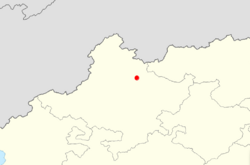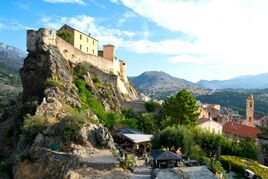Casamontagna: Difference between revisions
(Created page with "{{Infobox settlement | name = Casamontagna | native_name = | native_name_lang = | settlement_type = City | image_skyline...") |
No edit summary |
||
| (4 intermediate revisions by the same user not shown) | |||
| Line 8: | Line 8: | ||
| total_width = 280 | | total_width = 280 | ||
| perrow = 1/2/2/2 | | perrow = 1/2/2/2 | ||
| image1 = | | image1 = Beauty of Vitruvia.jpg | ||
| image2 = VP-nuit.jpg | | image2 = VP-nuit.jpg | ||
| image3 | | image3 = Facing Outwards.png | ||
| color = white | | color = white | ||
| footer = '''From top, left to right''': | | footer = '''From top, left to right''': The Maupertuis Citadel; Casamontagna facing north; The outskirts of the town, showing the outer Tarantine Mountains | ||
}} | }} | ||
| image_alt = | | image_alt = | ||
| Line 25: | Line 24: | ||
| nickname = | | nickname = | ||
| motto = "A Camera di u Principe" | | motto = "A Camera di u Principe" | ||
| image_map = | | image_map = File:Casamontagna.png | ||
| map_alt = | | map_alt = | ||
| map_caption = | | map_caption = Casamontagna inside of the Catturaterra State | ||
| image_map2 = | | image_map2 = | ||
| map_alt2 = | | map_alt2 = | ||
| Line 112: | Line 111: | ||
}} | }} | ||
Casamontagna ({{wp|Corsican language|Vitruvio}}: Casainmuntagna, {{wp|Croatian language| | Casamontagna ({{wp|Corsican language|Vitruvio}}: Casainmuntagna, {{wp|Croatian language|Novalian}}: Planinskigrad) is a town, civil parish and state capital of [[Catturaterra]]. The town acts as the cultural capital of the [[Novalians in Vitruvia|Novalian population in Vitruvia]] as well as the largest settlement in the country inside the [[Tarantine Mountains]]. It is located 9 miles (14 km) north of [[Corte]] and around 19 miles (31 km) south-east of [[Lucciana]]. | ||
It has ancient historic origins originating back to the Piraean Territories which can still be seen in a number of historic buildings. It was once a major fortified settlement that defined the border between various city states and kingdoms throughout history. The population was 50,923 as of the 2019 census. | It has ancient historic origins originating back to the Piraean Territories which can still be seen in a number of historic buildings. It was once a major fortified settlement that defined the border between various city states and kingdoms throughout history. The population was 50,923 as of the 2019 census. | ||
| Line 118: | Line 117: | ||
==History== | ==History== | ||
===Piraean occupation=== | ===Piraean occupation=== | ||
Archaeological evidence suggests the Piraean influence begins as early as 600 BCE. Originally, it is thought that the settlement was used as a defensive fortification separating the outer territories with the Tarantines. | |||
===Kingdom of Furiani=== | ===Kingdom of Furiani=== | ||
===Kingdom of Acquaviva=== | ===Kingdom of Acquaviva=== | ||
| Line 130: | Line 130: | ||
==References== | ==References== | ||
{{reflist}} | {{reflist}} | ||
[[Category:Vitruvia]] | |||
Latest revision as of 09:22, 4 April 2023
Casamontagna | |
|---|---|
City | |
From top, left to right: The Maupertuis Citadel; Casamontagna facing north; The outskirts of the town, showing the outer Tarantine Mountains | |
| Motto: "A Camera di u Principe" | |
 Casamontagna inside of the Catturaterra State | |
| Country | |
| State | Catturaterra |
| Founded by | Leofricu, Earl of Catturaterra |
| Population (2019) | |
| • Total | 50,923 |
Casamontagna (Vitruvio: Casainmuntagna, Novalian: Planinskigrad) is a town, civil parish and state capital of Catturaterra. The town acts as the cultural capital of the Novalian population in Vitruvia as well as the largest settlement in the country inside the Tarantine Mountains. It is located 9 miles (14 km) north of Corte and around 19 miles (31 km) south-east of Lucciana.
It has ancient historic origins originating back to the Piraean Territories which can still be seen in a number of historic buildings. It was once a major fortified settlement that defined the border between various city states and kingdoms throughout history. The population was 50,923 as of the 2019 census.
History
Piraean occupation
Archaeological evidence suggests the Piraean influence begins as early as 600 BCE. Originally, it is thought that the settlement was used as a defensive fortification separating the outer territories with the Tarantines.



